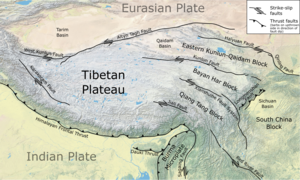

| Longmenshan Fault | |||||||||
|---|---|---|---|---|---|---|---|---|---|
| Chinese | 龙门山断层 | ||||||||
| |||||||||
The Longmenshan Fault (Chinese: 龙门山断层) is a thrust fault which runs along the base of the Longmen Mountains in Sichuan province in southwestern China. The strike of the fault plane is approximately NE.[1] Motion on this fault is responsible for the uplift of the mountains relative to the lowlands of the Sichuan Basin to the east. Representing the eastern boundary of the Qinghai-Tibet Plateau, it is a border formation between the Bayan Kola block in the Plateau and the South China block in the Eurasian plate. The 2008 Wenchuan, 2013 Lushan and 2022 Ya'an earthquakes occurred along this fault.[2][3]
A study by the China Earthquake Administration (CEA) states:[2]
"The late-Cenozoic deformations in this fault (that caused the 2008 Wenchuan earthquake) are concentrated in the Guanxian-Jiangyou fracture (hill-front fracture), Yingxiu-Beichuan fracture (mid-fracture), Wenchuan-Mao County fracture (hill-back fracture), and their related folds. The recent Ms 8.0 earthquake occurred on the Yingxiu-Beichuan fracture, as a result of Longmenshan thrust pushing southeastward combined with clockwise shears.[4]
Since Holocene (10,000), Yingxiu-Beichuan fracture has had evident activities. Its long-term geological slip rate is slower than 1 mm per year. GPS observations confirm the current structural deformation of the Longmenshan formation to be characterized by thrust and right-handed shears, but with a low deformation rate. Therefore, Longmenshan formation and its internal fractures constitute a special type that has low earthquake frequences but the potential to cause super strong earthquakes.[5]"
- ^ Dong Jia, Dong; Wei, Guoqi; Chen, Zhuxin; Li, Benliang; Zeng, Qing; Yang, Guang; et al. (September 2006). "Longmen Shan fold-thrust be ilt and its relation to the western Sichuan Basin in central China: New insights from hydrocarbon exploration". AAPG Bulletin. 90 (9): 1425–1447. doi:10.1306/03230605076.
- ^ a b "汶川8.0級地震成因分析 (Cause Analysis of the M8.0 Wenchuan earthquake)" (in Chinese). China Earthquake Administration. 2008-05-30. Retrieved 2008-09-07.
- ^ Wang, Amber (1 June 2022). "Four dead as twin quakes shake Chinese city, epicentre of deadly 2013 shock". South China Morning Post. Retrieved 2 June 2022.
- ^ Chinese: 晚新生代的構造變形主要集中在灌縣-江油斷裂(前山斷裂)、映秀-北川斷裂(中央斷裂)和汶川-茂縣(後山斷裂)及其相關褶皺之上,這次8級強震發生在映秀-北川斷裂之上,是龍門山逆衝推覆體向東南方向推擠並伴隨順時針剪切共同作用的結果
- ^ Chinese: 映秀-北川斷裂全新世(10000年)以來具有明顯的活動性,其長期地質滑動速率小於每年1毫米。GPS觀測表明龍門山構造帶的現今構造變形也是以逆衝和右旋剪切為特徵,但變形速度不大。因而,龍門山構造帶及其內部斷裂屬於地震活動頻度低但具有發生超強地震的潛在危險的特殊斷裂。